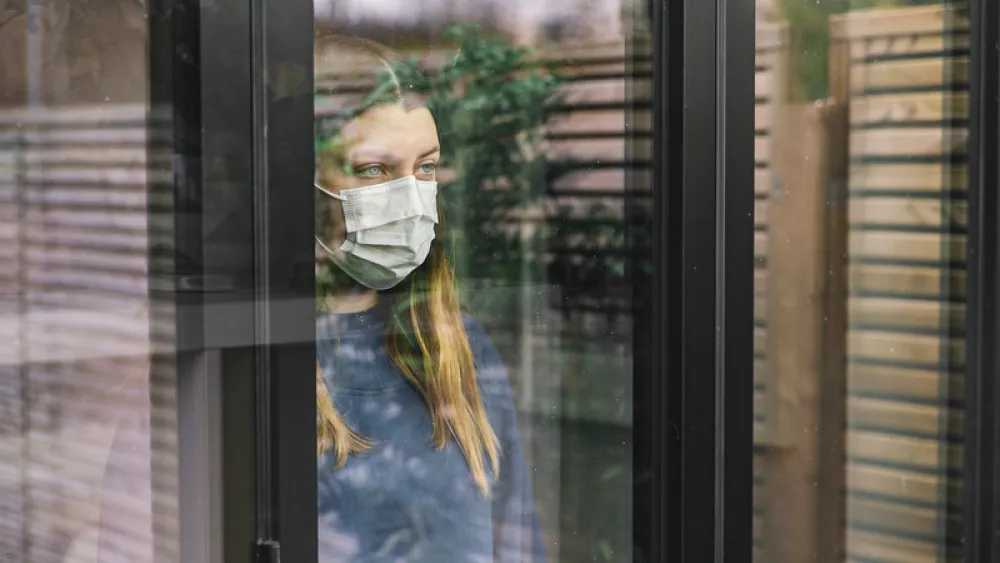




Healthy Lifestyle
Tips to Flatten the Anxiety Curve so Many of Us Are Experiencing
Published: April 3, 2020

By now, we’re quite familiar with the benefit of “flattening the curve” in reference to the coronavirus disease (COVID-19) pandemic.
We’re told if we can engage in simple practices such as frequent handwashing, maintaining a social distance of at least 6 feet and staying home as much as possible, we’re less likely to overwhelm medical facilities because the virus will spread slower.
Along with the many changes the pandemic has brought, many people are experiencing increased anxiety. Much like how together we can flatten the curve for COVID-19, we can individually flatten the curve for anxiety by better understanding how it originates and taking quick action to keep it from spiking or leading to panic attacks.
The Science of Anxiety
Anxiety starts in a place deep in the brain called the amygdala, which is composed of two small objects about the size of almonds. Despite its small size, the amygdala is very powerful. Whenever it senses there’s a threat to our safety, it sounds an alarm – whether we want it to or not. That alarm reaches the hypothalamus, which stimulates many of the body’s important processes, and sympathetic system, which can produce a fight-or-flight response.
If the body perceives a threat as an emotional emergency, it often responds by tensing muscles; increasing heart rate and respiration; and shutting down unneeded functions. At its extreme, the reaction can contribute to what many define as a panic attack.
The good news is the body also has a parasympathetic system, which kicks in to slow heart rate and ease muscle tension when a threat has been eliminated or is retreating. This system can be influenced by us so that the sympathetic system relaxes and anxiety is kept from spiraling out of control.
Tips to Relieve Anxiety
To flatten the anxiety curve, we need to learn how to engage the parasympathetic system as soon as we recognize we’re being emotionally triggered. Fortunately, it’s a relatively simple process. But, just like with our efforts to keep COVID-19 at bay, we need to be vigilant and proactive.
Here are some simple practices that can help lower your anxiety level. Most can be accomplished in a few seconds or minutes.
- Smile! When we smile, neurochemicals that calm the body are released. Even better, a smile can be contagious. Other people will smile back at you, releasing even more feel-good chemicals.
- Anticipate a positive event, such as traveling to a favorite vacation spot when it is safe to do so.
- Think about a positive memory. For example, remember and savor a compliment you received from a family member or even a stranger.
 Play music, especially music that soothes you. Experiment until you find music that’s particularly calming.
Play music, especially music that soothes you. Experiment until you find music that’s particularly calming.- Try deep breathing. When you’re truly breathing deeply, it’s impossible to experience anxiety. There are a variety of structured deep breathing exercises, such as breathing in to a count of four, holding your breath to a count of four and then exhaling to a count of six.
- Engage your senses. See, taste, touch, smell and hear what’s happening around you. By focusing on your environment, you “get out of your head” and appreciate what’s happening in the moment. Try eating a fresh strawberry with your eyes closed. Or counting the number of sounds you hear.
- Add loving-kindness meditation to your daily routine. Say: “May I be happy. May I be safe. May I be healthy and strong.” Then repeat twice, the first time thinking of a loved one and the second time thinking of someone that you have difficulty liking or loving.
- Color, doodle or paint. Employing the creative process is a wonderful way to practice self-soothing as well as process feelings.
- Experiment with yoga, tai chi or qigong. You don’t necessarily need to attend a class. (YouTube is full of examples.) Even practicing one pose or movement can be effective. For example, child’s pose has been proven to lower anxiety.
- Sing, hum or whistle. Making delightful sounds can enrich your own life and the lives of others.
- Give yourself a hug.
- Rock in a rocking chair.
- If you’re a person of faith, pray. Praying for others is especially effective.
- Stretch! If you put your hands behind your back, you’ll make deep breathing easier.
- Play or snuggle with your pet.
- Be grateful. Try to be thankful for something different each day. You’ll find yourself searching for the beauty in your daily routine.
- Write a handwritten thank-you note and mail it to someone who has made a difference in your life.
In addition to lowering anxiety, engaging the parasympathetic system also helps to enhance your immune system.
Help Is Available
Having anxiety is normal during challenging times. In addition to trying the ideas listed here, consider reaching out for additional help.
If you need help dealing with anxiety or feelings of fear, sadness or uncertainty, call the free Methodist Emotional Support Line at (402) 815-8255 (TALK). Licensed professional counselors can help by answering questions, addressing concerns, scheduling counseling appointments for additional care and providing referrals to community resources.
More Resources
- Read about being mindful of social isolation in this era of social distancing
- Here’s what you need to know about children and COVID-19
- Learn more about social distancing and how it could save lives
- Get similar articles delivered straight to your inbox
- Follow Methodist on Facebook, Twitter and Instagram for the latest COVID-19 updates


